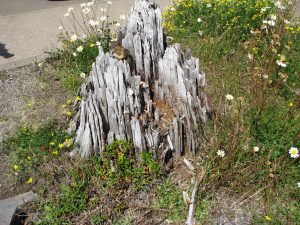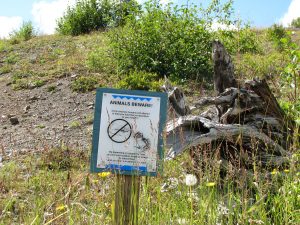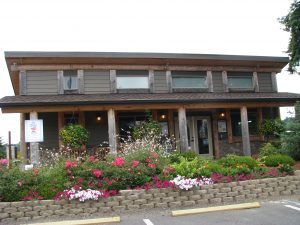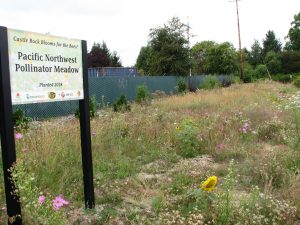On May 17th, 1980, I landed in Seattle on a 747 flight from London. My trip had begun that day in Paris, where I had spent two days following a convention in Metz, France. Now I transferred to a little 18-seater for the final leg, to Eugene.
We hadn’t been in the air long until the pilot told us that we were flying almost over Mount St. Helens, which had been in the news a lot lately because something seemed to be stirring down there in the depths of the Earth. We were able to look out the window and see the little pit (okay, probably a quarter of a mile across, but it looked little) that had formed over the past months. There was a plume of steam coming from that pit. It was very pretty.
I got home, feeling jet-lagged, crashed, woke up the next morning, turned on the TV news. There was a live shot from Portland, of the incredible, towering billows of smoke and ash rising 80,000 feet, fifteen miles high from the volcano, which is about sixty miles north of the city.
Imagine my surprise. What if I had missed my flight and had to stay in Seattle overnight, departing in the morning, just in time for the eruption at 8:32:17 AM? I figure I would either have an incredible memory of the largest landslide in recorded history, or not be here to tell about it at all.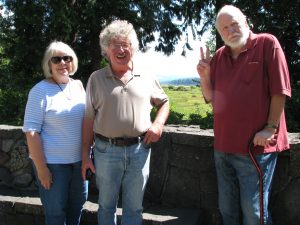
It is now 39 years later. Lee and I hadn’t been up to the mountain in quite a while, so when our Los Angeles friends Jon and Marion made their annual trip north we planned on driving there. We crossed our fingers, hoping for a clear day. If it is overcast, there isn’t much point in going up. You won’t even know there’s a mountain there.
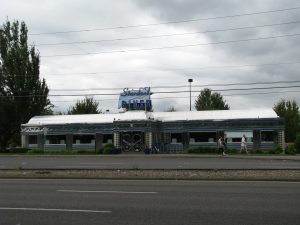 Breakfast at the fabulous Stardust Diner (best bacon in Vancouver) then north to the Castle Rock Visitors Center. This is the town where you get off the I-5 to access the road to the mountain. (No, it is not the setting for a lot of Stephen King stories. This is Washington.) We already knew there was no castle in Castle Rock, but Lee had seen some pictures of a big rock, and wanted to find it. But the nice young woman at the visitors center said it wasn’t really worth our time. I asked her how old she was when the mountain blew. She said she had been three, and remembered nothing about it. Now it was providing her a living.
Breakfast at the fabulous Stardust Diner (best bacon in Vancouver) then north to the Castle Rock Visitors Center. This is the town where you get off the I-5 to access the road to the mountain. (No, it is not the setting for a lot of Stephen King stories. This is Washington.) We already knew there was no castle in Castle Rock, but Lee had seen some pictures of a big rock, and wanted to find it. But the nice young woman at the visitors center said it wasn’t really worth our time. I asked her how old she was when the mountain blew. She said she had been three, and remembered nothing about it. Now it was providing her a living.
Just five miles east of the Interstate is the Visitors Center at Silver Lake, operated by Washington State Parks. I’m very glad we stopped because it is larger and more informative than the main tourist destination, the Johnston Ridge Observatory.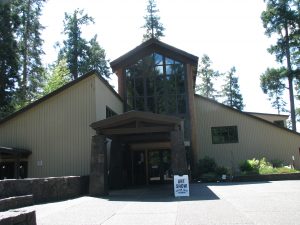
This place was deeply into the geology and history of the mountain and the region. We learned a lot. I had always sort of wondered how the mountain got its name. Now I learned it was named by George Vancouver, who explored the region in the 1790s and has no less than two cities and a National Historic Site named after him. It was in honor of his friend Lord Alleyne FitzHerbert, 1st Baron St Helens. Mr. Vancouver decided not to go with the name the native Cowlitz people used, which translates as Big Fucking Boom! The Cowlitz were around in 1480, when it erupted with many times the force of the one 500 years later.
The standout exhibit was a scale model of the mountain after it blew, with stairs leading down into the interior where one could look down a shaft into the molten magma below.
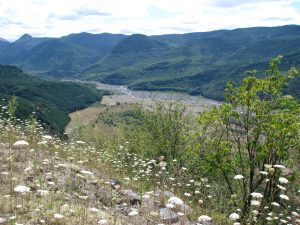 From there the road is steadily upward, then down a bit into a valley, and then up again to where the trees thinned out and finally disappeared altogether. There are still plenty of dead tree trunks that were blown down by the incredible force of the blast, which pretty much scoured hundreds of square miles right down to the ground. Within the National Volcanic Monument, the land will stay that way, untouched, unlogged, as the devastated region grows back.
From there the road is steadily upward, then down a bit into a valley, and then up again to where the trees thinned out and finally disappeared altogether. There are still plenty of dead tree trunks that were blown down by the incredible force of the blast, which pretty much scoured hundreds of square miles right down to the ground. Within the National Volcanic Monument, the land will stay that way, untouched, unlogged, as the devastated region grows back.
There’s a large parking lot just below the Johnston Ridge Observatory. You can’t see the mountain from there. We paused a while to look at a cheeky little chipmunk sitting in a rotting stump, looking like some sort of tourist souvenir. But even cute rodents lose their appeal after a while, so we hiked the short distance over the ridge to come up on a stunning view into the crater of Mount St. Helens.
(Admission to the building was $8/person. Some years ago we purchased a Golden Age Passport, good for a lifetime of free admission to National Parks, Monuments, and Federal Recreational Lands. Back then it was $10. Now it will set you back $80, but you have to be over 62. We hadn’t really used it, but now it came in handy.)
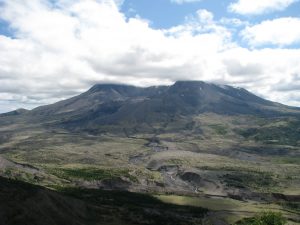 But first you linger over the view. We had the clear day we had wished for. The only thing that made it only slightly less than perfect is that there was cloud at the very top of the south crater wall, but we could see into the crater just fine. We could see the lava dome that has been slowly rebuilding the mountain. The Observatory is six miles north. You can get closer, but only on back roads and trails. Climbing is allowed these days.
But first you linger over the view. We had the clear day we had wished for. The only thing that made it only slightly less than perfect is that there was cloud at the very top of the south crater wall, but we could see into the crater just fine. We could see the lava dome that has been slowly rebuilding the mountain. The Observatory is six miles north. You can get closer, but only on back roads and trails. Climbing is allowed these days.
Later I learned that this place was built just about on the site where volcanologist David A. Johnson had set up his camp. He would have been at a different elevation, as the blast rearranged the landscape considerably. He was one of the first to see it, and the first to report it. “Vancouver! Vancouver! This is it!” he radioed, before being swept away by 0.7 of a cubic mile of red-hot rock, dust, and gas. No trace of him was ever found. It had to have been very quick.
Later, in the theater, we heard the recording of his last words, and it gave me goose bumps. He was instrumental in getting the state and feds to close the area, despite considerable pressure to keep it open for logging and tourism. Without question, they saved thousands of lives. Can you imagine, families camping, hiking, boating on Spirit Lake, which pretty much ceased to exist?
Even more harrowing were the exhibits of tales of some of the survivors that line one wall inside the building. Around 57 people died. No certain body count will ever be possible.
One more stat: People always like to compare big explosions to the bomb that destroyed much of Hiroshima. The force of this eruption was about 1,700 times bigger.
We usually don’t go to the films they show at places like this, but a recent good experience at Fort McHenry made me want to try it, and it was about to start in five minutes, so what the heck? This film was good, with CGI recreation of all the stages of the eruption and its immediate aftermath. But the best part was the finish. At McHenry when the filmed re-creation of the battle was over, the screen rolled up and we were looking out through a glass wall at the actual Fort, and the replica Old Glory was waving in the wind. Proudly I hailed it. At Johnston Ridge, the curtain went up and we were looking right into the crater, six miles away. If you go there, be sure to see the show.
On the way back to the car there were more chipmunks. These were as brazen as animals who are constantly exposed to humans sometimes get, coming right up to take food from the hands of several people. A chipmunk will spook at sudden movement, but if you move slowly they show no signs of fear. This is very cute, of course, but just a wee bit alarming to me. Some people forget that, big or small, these are wild animals. I thought of the recent incident in Yellowstone National Park, where several dozen visitors ignored the warning signs posted all over the place and actually went into a herd of bison to pet them and take selfies. Until one bull got angry about something and tossed a 9-year-old girl high in the air, making her the star of a very scary viral video. Through sheer luck, she wasn’t hurt badly. I haven’t heard if her parents were charged with criminal endangering, but they should be.
Well, you probably don’t need to fear wild chipmunks and squirrels too much (though years ago one came up to Lee and tried to run off with her toe). They don’t seem to have rabies, though they may carry plague and hantavirus. But avoid raccoons, badgers, minks and other weasels, armadillos (who carry leprosy!) and especially catamounts, elk, moose, and bears. Especially bears.
Although Lee and I had been through Longview several times in the last few years, on our way to or from something else, we didn’t know any restaurants other than a Sizzler, which didn’t seem like a good idea. So Marion put her phone to the test, and found a Mexican place called Monarca with good Yelp reviews.
It turned out to be a ways out of town, and was quite unprepossessing. Oh, well, we were all hungry, and Marion said it smelled right. We ordered at the counter. There was something on the wall menu called a huarache. I know about 100 Spanish nouns, give or take, and I thought the word meant shoe. I was almost right. Shoes are zapatos, but a huarache is a type of shoe. Of course, now I remember. I’ve seen many of them. The food huarache is called that because it is a bunch of mashed beans and beef and stuff served on an oblong tortilla shaped like a huarache sole. Three of us ordered that.
And it was quite good. I believe that the food we ate there was closer to what is served in Mexico, particularly in Mexico City, than the Mexican food we get in El Norte, which is mostly Tex-Mex.
And so back home. I’m not 40 anymore. Hell, I’m not 70 anymore. I was pooped out. But we had a great time.
* * *
When I was preparing this trip report Lee realized she hadn’t taken a picture of the Castle Rock Visitors Center, so a few days later we drove up there again. This time we entered by the I-5 business loop, from the south, and got a whole different picture of the place.
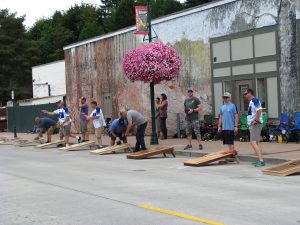 We arrived on the day of what seemed to be their Cornhole festival. What, you may ask, is Cornhole? I’d never heard of it myself. It is a game where people throw beanbags at boards with small holes in them, sort of like horseshoes. Apparently it has become quite popular, and the town of Castle Rock has gone crazy over it. Cornhole layouts completely covered three side blocks off the main drag. These guys (it all seemed to be guys) were very good. They seldom missed the distant board, and often got a bag right through the hole. They were dead serious about it.
We arrived on the day of what seemed to be their Cornhole festival. What, you may ask, is Cornhole? I’d never heard of it myself. It is a game where people throw beanbags at boards with small holes in them, sort of like horseshoes. Apparently it has become quite popular, and the town of Castle Rock has gone crazy over it. Cornhole layouts completely covered three side blocks off the main drag. These guys (it all seemed to be guys) were very good. They seldom missed the distant board, and often got a bag right through the hole. They were dead serious about it.
I have to admit that hearing about this sport gave me a bit of a jar. There is a definition for cornhole that is a bit … unsavory, unless you’re into that sort of thing. To spare delicate sensibilities, I won’t say what we knew cornholing to be when I grew up in Texas. Look it up.
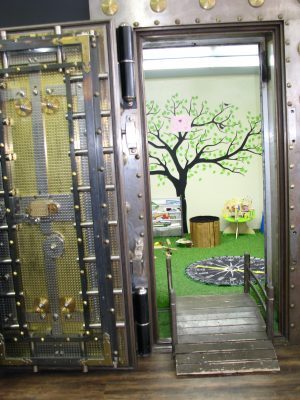 It was a nice little street fair, though we got there when most of the vendors were just starting to take down their tents. The most interesting thing was a place called Vault Books and Brew. The brew is coffee, not beer, and the books are mostly used. It is in what used to be the Castle Rock Bank. They still have the massive vault door, but inside is a children’s play area. I guess if the little buggers get too rowdy, they can just shut the door. The food part of the store was selling ice cream, and one flavor looked so intriguing to me that I had to try some. It was lemon meringue pie, and it was fabulous. I think it may be my new favorite flavor. My old fave was an exotic concoction made from an orchid called V. planifolia, more commonly known as vanilla.
It was a nice little street fair, though we got there when most of the vendors were just starting to take down their tents. The most interesting thing was a place called Vault Books and Brew. The brew is coffee, not beer, and the books are mostly used. It is in what used to be the Castle Rock Bank. They still have the massive vault door, but inside is a children’s play area. I guess if the little buggers get too rowdy, they can just shut the door. The food part of the store was selling ice cream, and one flavor looked so intriguing to me that I had to try some. It was lemon meringue pie, and it was fabulous. I think it may be my new favorite flavor. My old fave was an exotic concoction made from an orchid called V. planifolia, more commonly known as vanilla.
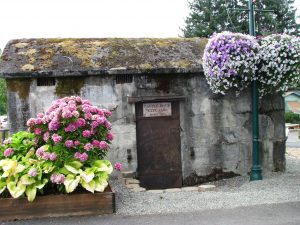 The little town of Castle Rock was festooned with more petunias than I had seen in one place for a while, and it had one more item of interest, which is the old City Jail, built in 1907. It was not much larger than a three-holer outhouse.
The little town of Castle Rock was festooned with more petunias than I had seen in one place for a while, and it had one more item of interest, which is the old City Jail, built in 1907. It was not much larger than a three-holer outhouse.
Finally we made it to our original objective, the Visitors Center. It might have been nice if we had spent another fifteen minutes or so looking at the outside when Jon and Marion were with us, but we were eager to get on to the mountain. We knew there were a lot of flower plantings around the building from the landscaping out front. But off to the side was a variegated and well-maintained Signature Garden that was worth a look, and on the other side of the parking lot was the Pacific Northwest Pollinator Meadow, a riot of wildflowers.
August 20, 2019
Vancouver, WA

